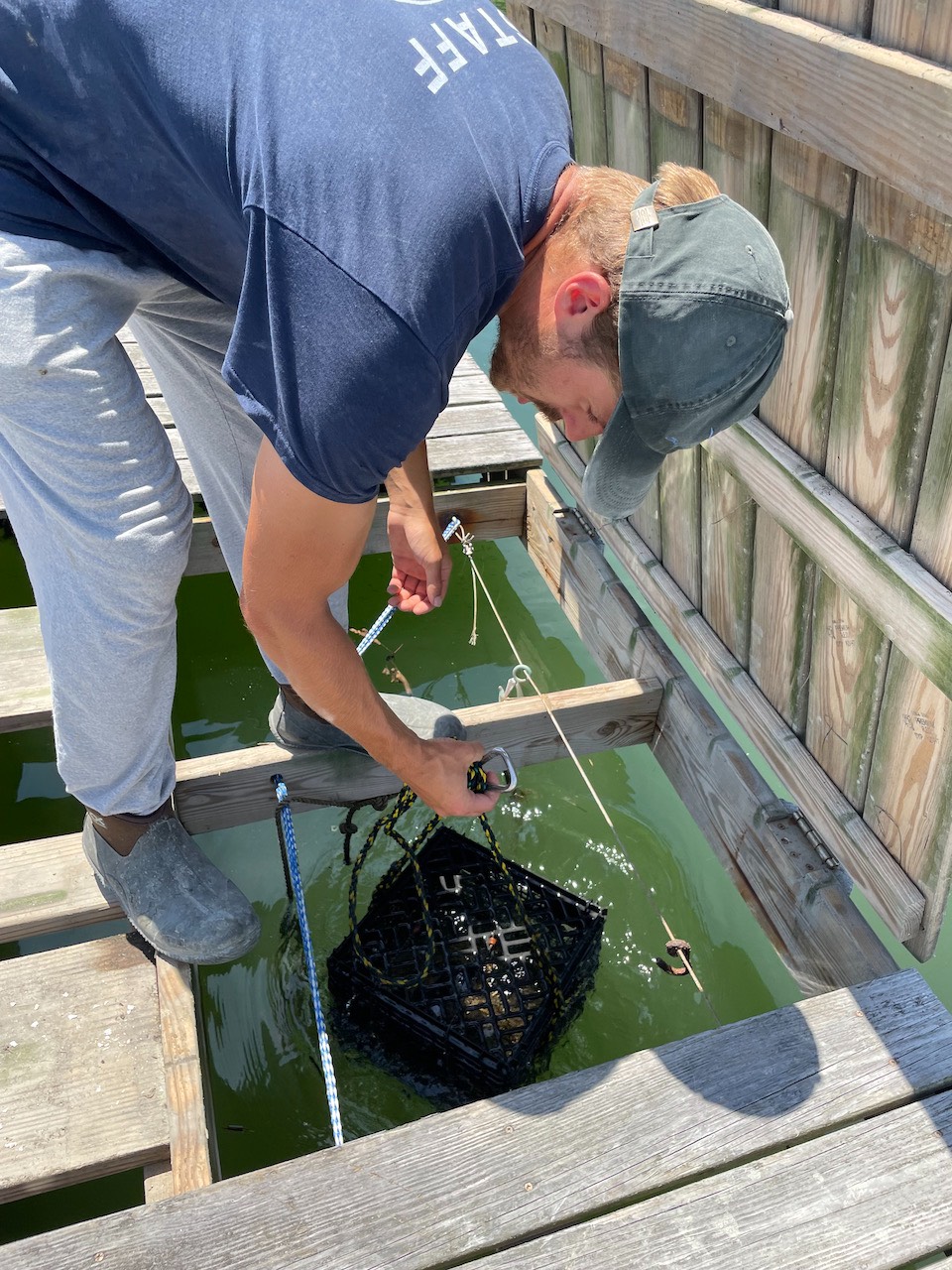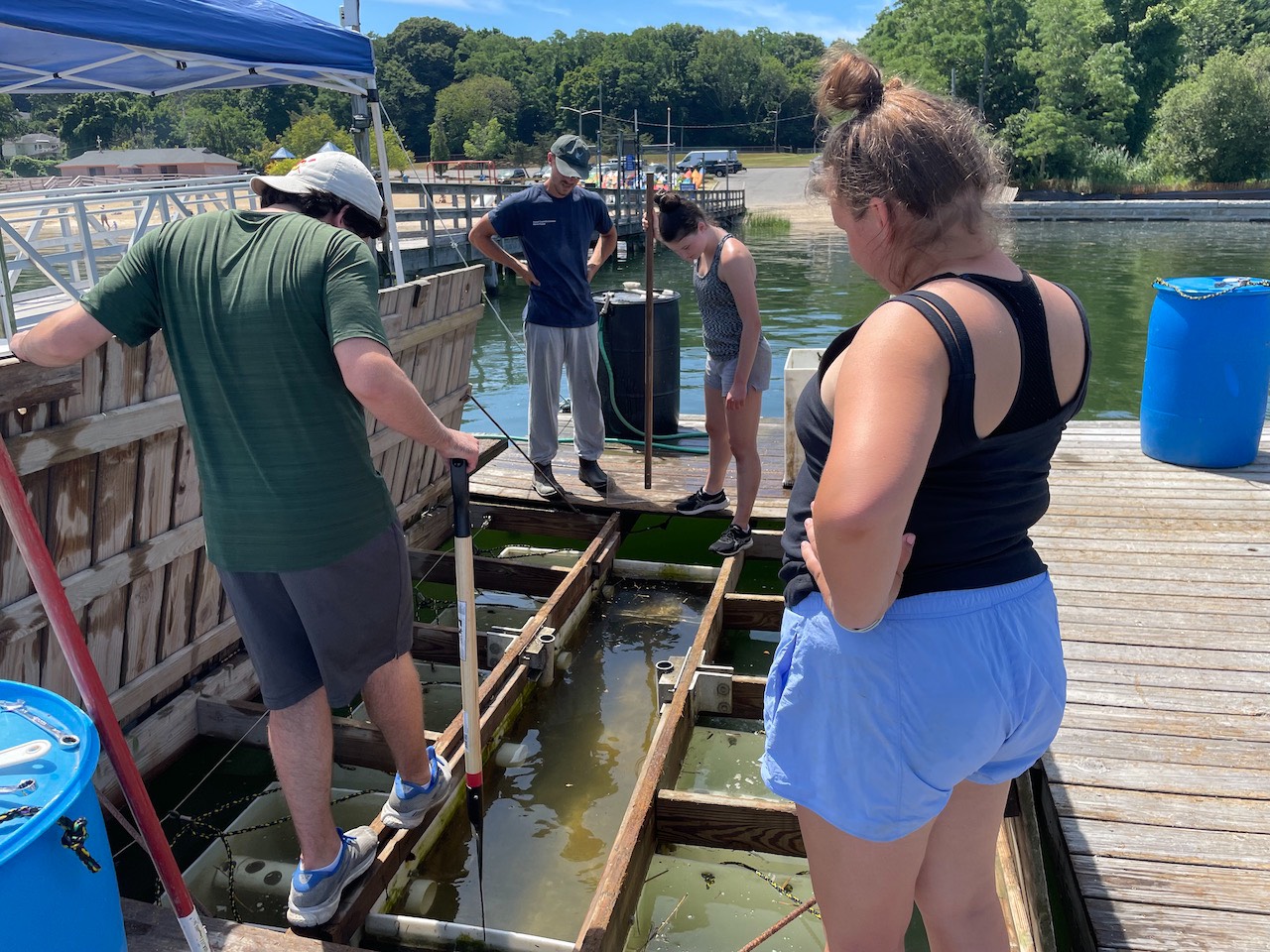Everyday Environmentalism
A FLUPSY of Filterers, Oodles of Oysters, & a CARE-ing Community
The high-end homes ringing Huntington Harbor and the dozens of boats moored in its waters make the view from Gold Star Beach Park a unique kind of picturesque. Even on a weekday like today people lounge in beach chairs, enjoying the clear skies and charming view. At the end of a narrow dock jutting a few hundred feet into the water, the marina's puttering launch ferries people back and forth to their personal boats. But there's more going on here than the usual seaside leisure activities. Halfway down that dock several wooden platforms float attached to one side. A blue sign labels them as a restricted area and an Aquaculture Facility of the Town of Huntington. On the surface it doesn't look like anything noteworthy, but below those platforms some of the most vital marine restoration work on eastern Long Island takes place.
Demetrios Caroussos, a conservationist with the Cornell Cooperative Extension's Suffolk County Marine Division and current master’s candidate in Stony Brook's Marine Conservation and Policy program, watches three seasonal employees as they open hatches in one of the platforms and haul up mesh-bottomed plastic crates full of young clams that hang in the water below. The team here regularly brings these tiny shellfish, sorted by size, to the surface like this so that they and the delightfully named "FLUPSY" that keeps water flowing over them can be cleaned and maintained.
Demetrios explains to me that the name stands for “Floating Upweller System.” It's essentially a pump that houses and protects the young animals while reproducing the natural upwelling process whereby colder, nutrient-rich water rises up the water column, providing food to critters like these shellfish. The clams housed in this FLUPSY, spawned in February, will be distributed in various places across Long Island sometime in October. Some will be placed in areas open to human harvest and eventually wind up on dinner plates. Others will go in off-limits stretches of water to act as natural reefs and, even more importantly, as much-needed natural water filters.
It’s been a tough couple of decades for the waters of Long Island and New York City, environmentally-speaking. And two of the biggest problems that have killed off much of the aquatic life in the area are closely intertwined: pollutant runoff and deadly phytoplankton blooms (you may know them as red or brown tides). Basically what happens is runoff from fertilizer and faulty sewage systems (or septic systems in much of Long Island's case) causes the population of certain planktons (some of which are toxic already) to explode to levels that poison and/or choke off the rest of the marine life in the region.
One way to prevent these red or brown tides is to prevent runoff. But that takes a lot of money from municipalities and individuals, and can be complicated. Long Island needs to invest more in those efforts, but nothing is happening quickly. But there’s another way to prevent runoff: putting literal tons of shellfish in the water. "Shellfish are a natural line of defense because they can filter the water very well," Demetrios explains. "A clam can filter roughly 25 gallons of water a day, an oyster can filter about 50 gallons of water a day. You can imagine a bay totally choked with oysters: there's not really a chance for anything to take over that water."
That's what the FLUPSY full of clams is here for. And it's just one of the ongoing restoration projects on these docks.
As the day goes on, Demetrios and his crew tackle maintenance on two additional vital shellfish programs dangling under the facility's other platforms.
One could be the start of a huge boon to contaminated waterways, bays, and beaches: several baskets of rib mussels. While they’re too rubbery for humans to enjoy eating, Demetrios and his colleagues demonstrate their value as sources of animal feed and natural fertilizer. But there's more to them than a possible source of additional income for shellfish farmers. Rib mussels can actually filter bacteria from water. Bacteria like E. coli and other strains tied to human fecal matter. And given the aforementioned issues with septic system runoff, adding more rib mussels to the waters around Long Island could be a huge step forward in keeping them clean.
The final project, according to Demetrios, could be the most important at this aquaculture facility. "We can grow all the oysters in the world, we can put them in the water. But if people don't care about them, if people don't know about them, then all of a sudden we get another brown tide that kills all the oysters we just spent three years growing. That would be devastating. And that is just one small example of why it's so important to have community involvement." It's this mentality that led to the Huntington Northport Oyster Reef Project, sometimes referred to as Oyster CARE (Community Aquaculture Restoration Education). It began last year, before Demetrios began working here at the aquaculture facility. But it’s easy to understand why he’s so passionate about it.
Working with the Huntington Rotary Club, dozens of volunteers come here on alternating Fridays and Saturdays to help take care of several large crates of oysters hanging below yet another platform here and other sites at several local yacht clubs. Think of it like a Suffolk County answer to NYC’s much-lauded Billion Oyster Project. They're grown by what's called the "spat on shell" method where multiple juvenile oysters are attached to a single shell and grown in a clump. This technique is used only to build oysters reefs rather than for human harvest. Once they're released into the wild, these oysters will spend their lives as water filterers, storm breaks, and the foundation of homes for many more marine organisms. All with the assistance of the citizens who call these seaside towns home.
It's this aspect, effectively communicating with the public by directly engaging them in scientific work, that Demetrios finds particularly worthwhile about this project. "For us to get our work out to the general public and for the general public to be receptive to it is the most important thing. And it's probably the most worthwhile thing we can do as scientists. Not just here, but in the realm of science in general. I think there's a stigma out there that science goes over people's heads a lot and I don't think that has to be true. I don't think science going over the general public's head is a burden on the general public. I think that's a burden on the scientists to be able to effectively communicate the work they're doing and explain to them why it matters. And there's no better way to explain to people why it matters than to get here, show them the oysters, show them the water."

Alt text: Demetrios shucking some oysters caught nearby for lunch.

Alt text: Removing a blue crab from one of the oyster containers.

Alt text: Pulling up one of the crates of oysters in order to inspect and clean it.

Alt text: Clumps of grown oysters bred by the spat-on-shell method.

Alt text: Demetrios and the seasonal employees preparing to clean the FLUPSY.
